Modern Digital and Technological Educational Methods
Abstract
1. Introduction
2. Materials and Methods
2.1. Data Collection
2.2. Data Extraction and Selection Inclusion Criteria
2.3. Inclusion Criteria
2.4. Data Processing and Analysis
2.5. Citation Analysis
2.6. Keyword Co-Occurrence Analysis
2.7. Co-Authorship and Collaboration Networks
2.8. The Use of Artificial Intelligence Tools in Manuscript Preparation
- (a)
- ZeroGPT, https://www.zerogpt.com/ (accessed on 25 April 2025);
- (b)
- PlagiarismDetector.net (AI Detector), https://plagiarismdetector.net/ai-content-detector (accessed on 25 April 2025).
3. Results
3.1. Quantitative Analysis
3.2. Analysis of the Most Cited Articles
3.3. Keyword Co-Occurrence Analysis
- The red area is related to education and digital technologies, including keywords such as “e-learning”, “students”, “digital technologies”, “virtual reality”, and “artificial intelligence”.
- The green area focuses on social sciences and health, with keywords such as “human”, “woman”, “man”, “health”, “social media”, and “digital health”.
- The blue area concerns both the educational process and teaching methods, including words such as “learning”, “education”, and “problem-based learning”.
- The purple area is associated with medical education, consisting of terms such as “medical”, “students”, and “dental education”.
- The yellow zone on the right is related to education and digital technologies (“e-learning”, “students”, “digital technologies”, “virtual reality”, “artificial intelligence”), with the most recent of these studies focusing on the digitalization of education and its adoption of new technologies.
- The green area in the center and left includes the social and health sciences (“human”, “health”, “digital health”, “social media”), with a particular emphasis on telemedicine and online communication issues.
- The blue area concerns the educational process (“education”, “learning”, “problem-based learning”).
- The dark blue area delimits keywords, such as “patient education” and “surveys and questionnaires”, focusing on a time period of past years.
3.4. Co-Citation and Bibliographic Coupling
4. Discussion
4.1. Adaptive Learning
4.2. Gamification
4.3. Microlearning
4.4. Learning Through Virtual/Augmented Reality (VR/AR)
5. Limitations and Further Research
6. Conclusions
Author Contributions
Funding
Institutional Review Board Statement
Informed Consent Statement
Data Availability Statement
Acknowledgments
Conflicts of Interest
References
- Siemens, G. Connectivism: A Learning Theory for the Digital Age. Int. J. Instr. Technol. Distance Learn. 2005. Available online: https://jotamac.typepad.com/jotamacs_weblog/files/connectivism.pdf (accessed on 1 April 2025).
- Bates, W.A. Teaching in a Digital Age—Second Edition; Tony Bates Associates Ltd.: Vancouver, BC, Canada, 2019. Available online: https://pressbooks.bccampus.ca/teachinginadigitalagev2/ (accessed on 20 February 2025).
- Anderson, T.; Dron, J. Teaching Crowds: Learning and Social Media; Athabasca University Press: Athabasca, AB, Canada, 2014; ISBN 978-1-927356-81-4. [Google Scholar]
- Adam, K.; Bakar, N.A.A.; Fakhreldin, M.A.I.; Majid, M.A. Big Data and Learning Analytics: A Big Potential to Improve e-Learning. Adv. Sci. Lett. 2018, 24, 7838–7843. [Google Scholar] [CrossRef]
- Means, B.; Toyama, Y.; Murphy, R.; Bakia, M.; Jones, K. Evaluation of Evidence-Based Practices in Online Learning A Meta-Analysis and Review of Online Learning Studies; U.S. Department of Education Office of Planning, Evaluation, and Policy Development Policy and Program Studies Service: Center for Technology in Learning, 2009. Available online: https://www.ed.gov/sites/ed/files/rschstat/eval/tech/evidence-based-practices/finalreport.pdf (accessed on 1 April 2025).
- Ribeiro, J.; Selwyn, N. Is Technology Good for Education. John Wiley & Sons: Toronto, ON, USA, 2016; p. 160, ISBN: 978-0-7456-9646-1. Can. J. Educ. Adm. Policy 2017, 182, 42–45. [Google Scholar]
- Johnson, A.M.; Jacovina, M.E.; Russell, D.G.; Soto, C.M. Challenges and Solutions when Using Technologies in the Classroom. In Adaptive Educational Technologies for Literacy Instruction; Crossley, S.A., McNamara, D.S., Eds.; Routledge: New York, NY, USA, 2016; pp. 13–30. ISBN 978-1-315-64750-0. [Google Scholar] [CrossRef]
- Becker Adams, S.; Cummins, M.; Davis, A.; Freeman, A.; Hall Giesinger, C.; Ananthanarayanan, V. NMC Horizon Report: 2017 Higher Education Edition; NMC, The New Media Consortium: Austin, TX, USA, 2017; ISBN 978-0-9977215-7-7. [Google Scholar]
- Laurillard, D. Rethinking University Teaching: A Conversational Framework for the Effective Use of Learning Technologies, 2nd ed.; Routledge/Falmer: London, UK, 2002; ISBN 978-0-415-25679-7. [Google Scholar]
- Selwyn, N. Education and Technology: Key Issues and Debates, 3rd ed.; Bloomsbury Academic Bloomsbury Publishing Plc.: London, UK, 2022; ISBN 978-1-3501-4554-2. [Google Scholar]
- Mongeon, P.; Paul-Hus, A. The journal coverage of Web of Science and Scopus: A comparative analysis. Scientometrics 2016, 106, 213–228. [Google Scholar] [CrossRef]
- Falagas, M.E.; Pitsouni, E.I.; Malietzis, G.A.; Pappas, G. Comparison of PubMed, Scopus, Web of Science, and Google Scholar: Strengths and weaknesses. FASEB J. 2008, 22, 338–342. [Google Scholar] [CrossRef] [PubMed]
- Baas, J.; Schotten, M.; Plume, A.; Côté, G.; Karimi, R. Scopus as a curated, high-quality bibliometric data source for academic research in quantitative science studies. Quant. Sci. Stud. 2020, 1, 377–386. [Google Scholar] [CrossRef]
- Burnham, J.F. Scopus database: A review. Biomed. Digit. Libr. 2006, 3, 1. [Google Scholar] [CrossRef]
- Chadegani, A.A.; Salehi, H.; Yunus, M.M.; Farhadi, H.; Fooladi, M.; Farhadi, M.; Ebrahim, N.A. A Comparison between Two Main Academic Literature Collections: Web of Science and Scopus Databases. ASS 2013, 9, p18. [Google Scholar] [CrossRef]
- Webster, J.; Watson, R.T. Analyzing the past to prepare for the future: Writing a literature review. MIS Q. 2002, 26, xiii–xxiii. [Google Scholar]
- van Eck, N.J.; Waltman, L. Software survey: VOSviewer, a computer program for bibliometric mapping. Scientometrics 2010, 84, 523–538. [Google Scholar] [CrossRef]
- Stoumpos, A.I.; Talias, M.A.; Ntais, C.; Kitsios, F.; Jakovljevic, M. Knowledge Management and Digital Innovation in Healthcare: A Bibliometric Analysis. Healthcare 2024, 12, 2525. [Google Scholar] [CrossRef]
- Small, H. Co-citation in the scientific literature: A new measure of the relationship between two documents. J. Am. Soc. Inf. Sci. 1973, 24, 265–269. [Google Scholar] [CrossRef]
- Kokotsaki, D.; Menzies, V.; Wiggins, A. Project-based learning: A review of the literature. Improv. Sch. 2016, 19, 267–277. [Google Scholar] [CrossRef]
- Hatzinakos, D.; Nikias, C.L. Blind equalization using a tricepstrum-based algorithm. IEEE Trans. Commun. 1991, 39, 669–682. [Google Scholar] [CrossRef]
- Kessler, H.; Mathers, S.; Sobisch, H.-G. The capture and dissemination of integrated 3D geospatial knowledge at the British Geological Survey using GSI3D software and methodology. Comput. Geosci. 2009, 35, 1311–1321. [Google Scholar] [CrossRef]
- Fierson, W.M.; Capone, A.; The American Academy of Pediatrics Section on Ophthalmology, American Academy of Ophthalmology, and American As-sociation of Certified Orthoptists; Granet, D.B.; Blocker, R.J.; Bradford, G.E.; Lehman, F.S.S.; Rubin, S.E.; Siatkowski, R.M.; Ruben, J.B. Telemedicine for Evaluation of Retinopathy of Prematurity. Pediatrics 2015, 135, e238–e254. [Google Scholar] [CrossRef]
- Wen, K.-Y.; Kreps, G.; Zhu, F.; Miller, S. Consumers’ Perceptions About and Use of the Internet for Personal Health Records and Health Information Exchange: Analysis of the 2007 Health Information National Trends Survey. J. Med. Internet Res. 2010, 12, e73. [Google Scholar] [CrossRef]
- Chen, X.; Chang-Richards, A.Y.; Pelosi, A.; Jia, Y.; Shen, X.; Siddiqui, M.K.; Yang, N. Implementation of technologies in the construction industry: A systematic review. Eng. Constr. Archit. Manag. 2022, 29, 3181–3209. [Google Scholar] [CrossRef]
- Tavel, M.E. Cardiac Auscultation: A Glorious Past—And It Does Have a Future! Circulation 2006, 113, 1255–1259. [Google Scholar] [CrossRef]
- Cukurova, M.; Luckin, R.; Millán, E.; Mavrikis, M. The NISPI framework: Analysing collaborative problem-solving from students’ physical interactions. Comput. Educ. 2018, 116, 93–109. [Google Scholar] [CrossRef]
- O’Reilly, M.K.; Reese, S.; Herlihy, T.; Geoghegan, T.; Cantwell, C.P.; Feeney, R.N.M.; Jones, J.F.X. Fabrication and assessment of 3D printed anatomical models of the lower limb for anatomical teaching and femoral vessel access training in medicine. Anat. Sci. Ed. 2016, 9, 71–79. [Google Scholar] [CrossRef]
- Montello, D.R. Cognitive Research in GIScience: Recent Achievements and Future Prospects. Geogr. Compass 2009, 3, 1824–1840. [Google Scholar] [CrossRef]
- Mustafa, N.; Ismail, Z.; Tasir, Z.; Mohamad Said, M.N.H. A Meta-Analysis on Effective Strategies for Integrated STEM Education. Adv. Sci. Lett. 2016, 22, 4225–4228. [Google Scholar] [CrossRef]
- Huang, C. Designing high-quality interactive multimedia learning modules. Comput. Med. Imaging Graph 2005, 29, 223–233. [Google Scholar] [CrossRef] [PubMed]
- Liu, Z.-Y.; Shaikh, Z.A.; Gazizova, F. Using the Concept of Game-Based Learning in Education. Int. J. Emerg. Technol. Learn. 2020, 15, 53. [Google Scholar] [CrossRef]
- Ren, Z.; Wan, J.; Deng, P. Machine-Learning-Driven Digital Twin for Lifecycle Management of Complex Equipment. IEEE Trans. Emerg. Top. Comput. 2022, 10, 9–22. [Google Scholar] [CrossRef]
- Liu, Z.-J.; Tretyakova, N.; Fedorov, V.; Kharakhordina, M. Digital Literacy and Digital Didactics as the Basis for New Learning Models Development. Int. J. Emerg. Technol. Learn. 2020, 15, 4. [Google Scholar] [CrossRef]
- Fuchsova, M.; Korenova, L. Visualisation in Basic Science and Engineering Education of Future Primary School Teachers in Human Biology Education Using Augmented Reality. Eur. J. Contemp. Educ. 2019, 8, 92–102. [Google Scholar] [CrossRef]
- Parham, G.P.; Mwanahamuntu, M.H.; Pfaendler, K.S.; Sahasrabuddhe, V.V.; Myung, D.; Mkumba, G.; Kapambwe, S.; Mwanza, B.; Chibwesha, C.; Hicks, M.L.; et al. eC3VA Modern Telecommunications Matrix for Cervical Cancer Prevention in Zambia. J. Low. Genit. Tract Dis. 2010, 14, 167–173. [Google Scholar] [CrossRef]
- Frolova, E.V.; Rogach, O.V.; Ryabova, T.M. Digitalization of education in modern scientific discourse: New trends and risks analysis. Eur. J. Contemp. Educ. 2020, 9, 331–336. [Google Scholar] [CrossRef]
- Calazans, N.L.V.; Moraes, F.G. Integrating the teaching of computer organization and architecture with digital hardware design early in undergraduate courses. IEEE Trans. Educ. 2001, 44, 109–119. [Google Scholar] [CrossRef]
- Mesko, B.; Győrffy, Z.; Kollár, J. Digital Literacy in the Medical Curriculum: A Course With Social Media Tools and Gamification. JMIR Med. Educ. 2015, 1, e6. [Google Scholar] [CrossRef] [PubMed]
- Siemens, G. Learning Analytics: The Emergence of a Discipline. Am. Behav. Sci. 2013, 57, 1380–1400. [Google Scholar] [CrossRef]
- Picciano, A. Big Data and Learning Analytics in Blended Learning Environments: Benefits and Concerns. IJIMAI 2014, 2, 35. [Google Scholar] [CrossRef]
- Weltman, H.; Hussain, F.; Marcus, N. We Built It and They Came: An Adaptive eLearning Experience. In Australian Association for Engineering Education; School of Engineering, Macquarie University: Sydney, Australia, 2017. [Google Scholar]
- Wilson, K. The Knewton Platform: A General-Purpose Adaptive Learning Infrastructure; Knewton: New York, NY, USA, 2015. [Google Scholar]
- Ma, W.J.; Husain, M.; Bays, P.M. Changing concepts of working memory. Nat. Neurosci. 2014, 17, 347–356. [Google Scholar] [CrossRef]
- Walkington, C.A. Using adaptive learning technologies to personalize instruction to student interests: The impact of relevant contexts on performance and learning outcomes. J. Educ. Psychol. 2013, 105, 932–945. [Google Scholar] [CrossRef]
- Holmes, W.; Luckin, R. Intelligence Unleashed: An Argument for AI in Education; UCL Knowledge Lab: London, UK, 2016; ISBN 978-0-9924248-8-6. [Google Scholar]
- Almasri, F. Exploring the Impact of Artificial Intelligence in Teaching and Learning of Science: A Systematic Review of Empirical Research. Res. Sci. Educ. 2024, 54, 977–997. [Google Scholar] [CrossRef]
- Cakir, O. An Application of Personalized Adaptive Learning Systems in Calculus I Course. J. Learn. Teach. Digit. Age 2022, 7, 307–321. [Google Scholar] [CrossRef]
- Heffernan, N.T.; Heffernan, C.L. The ASSISTments Ecosystem: Building a Platform that Brings Scientists and Teachers Together for Minimally Invasive Research on Human Learning and Teaching. Int. J. Artif. Intell. Educ. 2014, 24, 470–497. [Google Scholar] [CrossRef]
- Christopoulos, A.; Mystakidis, S. Gamification in Education. Encyclopedia 2023, 3, 1223–1243. [Google Scholar] [CrossRef]
- Popenici, S.A.D.; Kerr, S. Exploring the impact of artificial intelligence on teaching and learning in higher education. Res. Pract. Technol. Enhanc. Learn. 2017, 12, 22. [Google Scholar] [CrossRef]
- Altawalbeh, K. Game-Based Learning: The Impact of Kahoot on a Higher Education Online Classroom. J. Educ. Technol. Instr. 2023, 2, 30–49. [Google Scholar] [CrossRef]
- Anderson, C.A.; Dill, K.E. Video Games and Aggressive Thoughts, Feelings, and Behavior in the Laboratory and in Life. J. Personal. Soc. Psychol. 2000, 78, 772–790. [Google Scholar] [CrossRef]
- Stott, A.; Neustaedter, C. Analysis of Gamification in Education. Surrey BC Can. 2013, 8, 36. [Google Scholar]
- Dichev, C.; Dicheva, D. Gamifying education: What is known, what is believed and what remains uncertain: A critical review. Int. J. Educ. Technol. High. Educ. 2017, 14, 9. [Google Scholar] [CrossRef]
- Samala, A.D.; Bojic, L.; Bekiroğlu, D.; Watrianthos, R.; Hendriyani, Y. Microlearning: Transforming Education with Bite-Sized Learning on the Go—Insights and Applications. Int. J. Interact. Mob. Technol. 2023, 17, 4–24. [Google Scholar] [CrossRef]
- Sathiyaseelan, B.; Mathew, J.; Nair, S. Microlearning and Learning Performance in Higher Education: A Post-Test Control Group Study. J. Learn. Dev. 2024, 11, 1–14. [Google Scholar] [CrossRef]
- Faunia, N.; Firdaus, R.; Widodo, S.; Fitriawan, H. The Diffusion of Digital EdApp-Based Learning Motivation Innovation for Students’ Social Science Learning Outcomes (Literature Studies). J. Teknol. Pendidik. 2025, 10, 173. [Google Scholar] [CrossRef]
- Hug, T. Micro Learning and Narration: Exploring possibilities of utilization of narrations and storytelling for the designing of “micro units” and didactical micro-learning arrangements. Pap. Present. Fourth Media Transit. Conf. 2005, 8, MiT4. [Google Scholar]
- Kapp, K.M. The Gamification of Learning and Instruction: Game-Based Methods and Strategies for Training and Education. Int. J. Gaming Comput.-Mediat. Simul. 2012, 4, 81–83. [Google Scholar]
- Ebbinghaus, H. Our knowledge concerning memory. Mem. A Contrib. Exp. Psychol. 2013, 20, 1–6. [Google Scholar] [CrossRef]
- Thalheimer, W. The Learning-Transfer Evaluation Model: Sending Messages to Enable Learning Effectiveness; 2018. Available online: https://www.worklearning.com/wp-content/uploads/2018/02/Thalheimer-The-Learning-Transfer-Evaluation-Model-Report-for-LTEM-v11.pdf (accessed on 1 April 2025).
- Jensen, L.; Konradsen, F. A review of the use of virtual reality head-mounted displays in education and training. Educ. Inf. Technol. 2018, 23, 1515–1529. [Google Scholar] [CrossRef]
- Piovesan, S.D.; Passerino, L.M.; Pereira, A.S. Virtual reality as a tool in the education. Int. Assoc. Dev. Inf. Soc. 2012. Available online: https://files.eric.ed.gov/fulltext/ED542830.pdf (accessed on 1 April 2025).
- Godoy, C.H., Jr. Augmented Reality for Education: A Review. Int. J. Innov. Sci. Res. Technol. 2020, 5, 39–45. [Google Scholar] [CrossRef]
- Cardullo, V.; Wang, C. Pre-service Teachers Perspectives of Google Expedition. Early Child. Educ. J. 2022, 50, 173–183. [Google Scholar] [CrossRef] [PubMed]
- Parong, J.; Mayer, R.E. Learning science in immersive virtual reality. J. Educ. Psychol. 2018, 110, 785–797. [Google Scholar] [CrossRef]
- Joy, M.; Aquino, M.; Castillo, L.M.; Estrada, R.T.; Gabrillo, S.M.; Pabito, R.P.; Padlan, E.S.; Vinluan, E.J.V. Classvr: The Road to Interactive and Effective Learning. 2019. Available online: https://www.researchgate.net/publication/356086767_CLASSVR_THE_ROAD_TO_INTERACTIVE_AND_EFFECTIVE_LEARNING (accessed on 1 April 2025).
- Bailenson, J. Experience on Demand: What Virtual Reality Is, How It Works, and What It Can Do; W.W. Norton & Company: New York, NY, USA, 2018. [Google Scholar]
- Radianti, J.; Majchrzak, T.A.; Fromm, J.; Wohlgenannt, I. A systematic review of immersive virtual reality applications for higher education: Design elements, lessons learned, and research agenda. Comput. Educ. 2020, 147, 103778. [Google Scholar] [CrossRef]
- Baker, R.S.; Hawn, A. Algorithmic Bias in Education. Int. J. Artif. Intell. Educ. 2022, 32, 1052–1092. [Google Scholar] [CrossRef]
- Clabaugh, G.K. The Educational Theory of Lev Vygotsky a multi-dimensional analysis. New Found. 2010, 1–18. Available online: https://studylib.net/doc/5854258/the-educational-theory-of-lev-vygotsky--an-analysis (accessed on 1 April 2025).
- Devi, K.S. Constructivist Approach to Learning based on the Concepts of Jean Piaget and Lev Vygotsky An Analytical Overview. J. Indian Educ. 2019, XLIV, 5–19. [Google Scholar]
- Zimmerman, B.J. Attaining Self-Regulation. In Handbook of Self-Regulation; Elsevier: Amsterdam, The Netherlands, 2000; pp. 13–39. ISBN 978-0-12-109890-2. [Google Scholar]
- Fredricks, J.A.; Blumenfeld, P.C.; Paris, A.H. School Engagement: Potential of the Concept, State of the Evidence. Rev. Educ. Res. 2004, 74, 59–109. [Google Scholar] [CrossRef]
- Reeve, J. How students create motivationally supportive learning environments for themselves: The concept of agentic engagement. J. Educ. Psychol. 2013, 105, 579–595. [Google Scholar] [CrossRef]
- Merchant, Z.; Goetz, E.T.; Cifuentes, L.; Keeney-Kennicutt, W.; Davis, T.J. Effectiveness of virtual reality-based instruction on students’ learning outcomes in K-12 and higher education: A meta-analysis. Comput. Educ. 2014, 70, 29–40. [Google Scholar] [CrossRef]
- Hamari, J.; Koivisto, J.; Sarsa, H. Does Gamification Work?—A Literature Review of Empirical Studies on Gamification. In Proceedings of the 2014 47th Hawaii International Conference on System Sciences, Waikoloa, HI, USA, 6–9 January 2014; IEEE: Waikoloa, HI, USA, 2014; pp. 3025–3034. [Google Scholar]
- Hew, K.F.; Brush, T. Integrating technology into K-12 teaching and learning: Current knowledge gaps and recommendations for future research. Educ. Tech. Res. Dev. 2007, 55, 223–252. [Google Scholar] [CrossRef]
- Dicheva, D.; Dichev, C.; Agre, G.; Angelova, G. Gamification in Education: A Systematic Mapping Study. Educ. Technol. Soc. 2015, 18, 75–88. [Google Scholar]
- Ertmer, P.A.; Ottenbreit-Leftwich, A. Removing obstacles to the pedagogical changes required by Jonassen’s vision of authentic technology-enabled learning. Comput. Educ. 2013, 64, 175–182. [Google Scholar] [CrossRef]
- Williamson, B. Big Data in Education: The Digital Future of Learning, Policy and Practice; SAGE Publications Ltd.: New York, NY, USA, 2017; ISBN 978-1-4739-4800-6. [Google Scholar]
- Reeves, T.C.; Lin, L. The research we have is not the research we need. Educ. Tech. Res. Dev. 2020, 68, 1991–2001. [Google Scholar] [CrossRef]
- Reynolds, R. JanvanDijk. The digital divide. Cambridge, UK: Polity, 208 pp. £17.99 (paperback) (ISBN 9781509534456). Asso. Info. Sci. Tech. 2020, 72, 136–138. [Google Scholar] [CrossRef]
- Warschauer, M. Technology and Social Inclusion: Rethinking the Digital Divide; MIT Press: Cambridge, MA, USA, 2003; ISBN 978-0-262-23224-1. [Google Scholar]
- Tondeur, J.; Van Braak, J.; Ertmer, P.A.; Ottenbreit-Leftwich, A. Understanding the relationship between teachers’ pedagogical beliefs and technology use in education: A systematic review of qualitative evidence. Educ. Tech. Res. Dev. 2017, 65, 555–575. [Google Scholar] [CrossRef]
- Blignaut, A.S.; Hinostroza, J.E.; Els, C.J.; Brun, M. ICT in education policy and practice in developing countries: South Africa and Chile compared through SITES 2006. Comput. Educ. 2010, 55, 1552–1563. [Google Scholar] [CrossRef]
- Ertmer, P.A.; Ottenbreit-Leftwich, A.T. Teacher Technology Change: How Knowledge, Confidence, Beliefs, and Culture Intersect. J. Res. Technol. Educ. 2010, 42, 255–284. [Google Scholar] [CrossRef]
- Resta, P.; Laferrière, T. Digital equity and intercultural education. Educ. Inf. Technol. 2015, 20, 743–756. [Google Scholar] [CrossRef]
- Weller, M. 25 Years of Ed Tech; Athabasca University Press: Athabasca, AB, Canada, 2020; ISBN 978-1-77199-306-7. [Google Scholar]
- Zhao, B.X. Educational Inequality: The Role of Digital Learning Resources. Lect. Notes Educ. Psychol. Public Media 2023, 7, 634–642. [Google Scholar] [CrossRef]
- Van De Werfhorst, H.G.; Kessenich, E.; Geven, S. The digital divide in online education: Inequality in digital readiness of students and schools. Comput. Educ. Open 2022, 3, 100100. [Google Scholar] [CrossRef] [PubMed]
- Wang, H.; Song, Y.; Zhu, X.; Cao, M. Revisiting the Digital Divide in Online Teaching—An Analysis of Urban-Rural Differences in Online Learning among Middle School Students. Open J. Soc. Sci. 2022, 10, 34–50. [Google Scholar] [CrossRef]
- Assefa, Y.; Gebremeskel, M.M.; Moges, B.T.; Tilwani, S.A.; Azmera, Y.A. Rethinking the digital divide and associated educational in(equity) in higher education in the context of developing countries: The social justice perspective. Int. J. Inf. Learn. Technol. 2025, 42, 15–32. [Google Scholar] [CrossRef]
- Gottschalk, F.; Weise, C. Digital equity and inclusion in education: An overview of practice and policy in OECD countries. Organ. Econ. Co-Oper. Dev. 2023, 299, 1–75. [Google Scholar]
- Cuban, L. Oversold and Underused: Computers in the Classroom; Harvard University Press: Cambridge, MA, USA, 2001; ISBN 978-0-674-00602-7. [Google Scholar]
- Mishra, P.; Koehler, M.J. Technological Pedagogical Content Knowledge: A Framework for Teacher Knowledge. Teach. Coll. Rec. 2006, 108, 1017–1054. [Google Scholar] [CrossRef]
- Anderson, R.E.; Dexter, S. School Technology Leadership: An Empirical Investigation of Prevalence and Effect. Educ. Adm. Q. 2005, 41, 49–82. [Google Scholar] [CrossRef]
- Aoun, J. Robot-Proof: Higher Education in the Age of Artificial Intelligence; First MIT Press Paperback Edition; The MIT Press: Cambridge, MA, USA, London, UK, 2018; ISBN 978-0-262-03728-0. [Google Scholar]
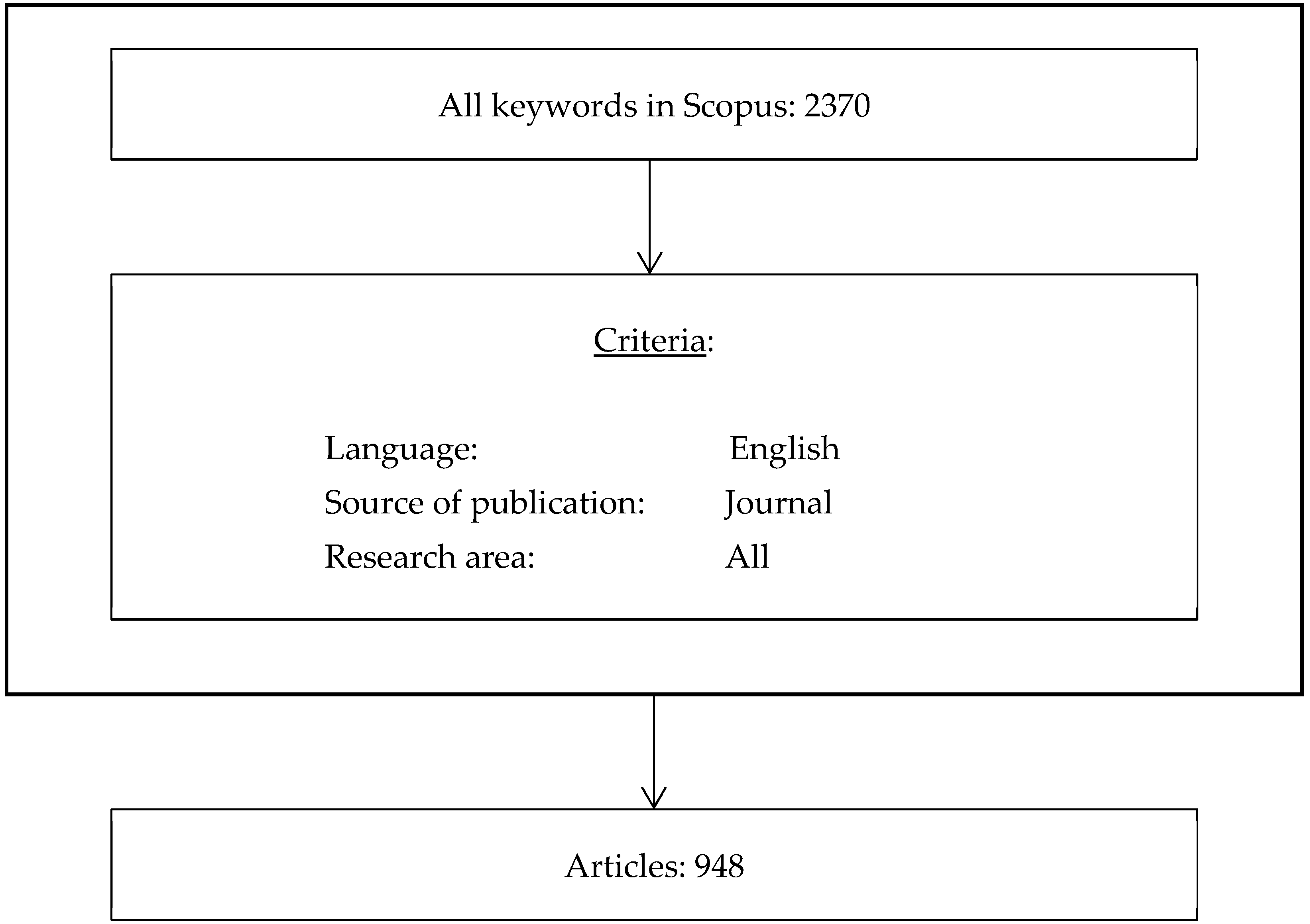
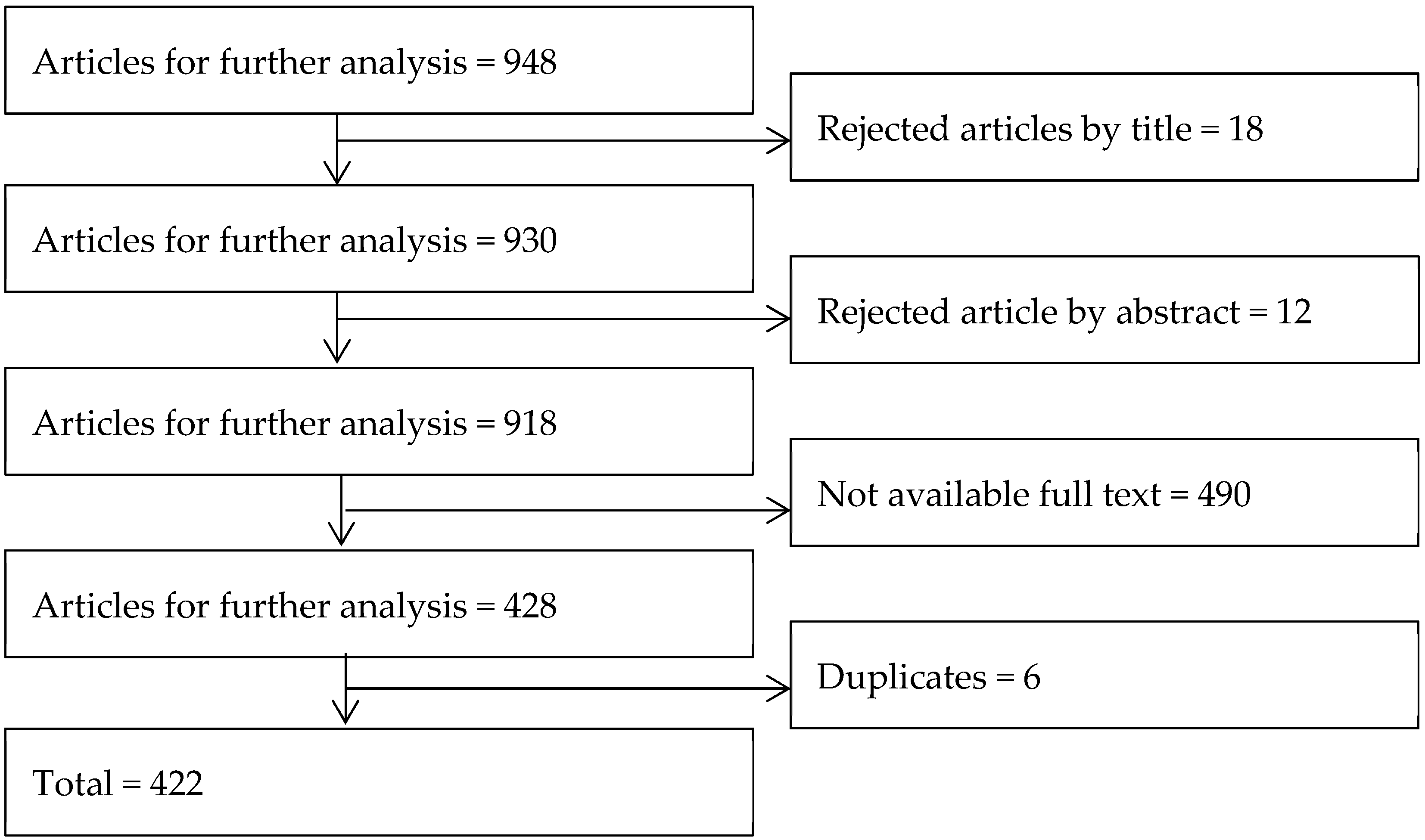
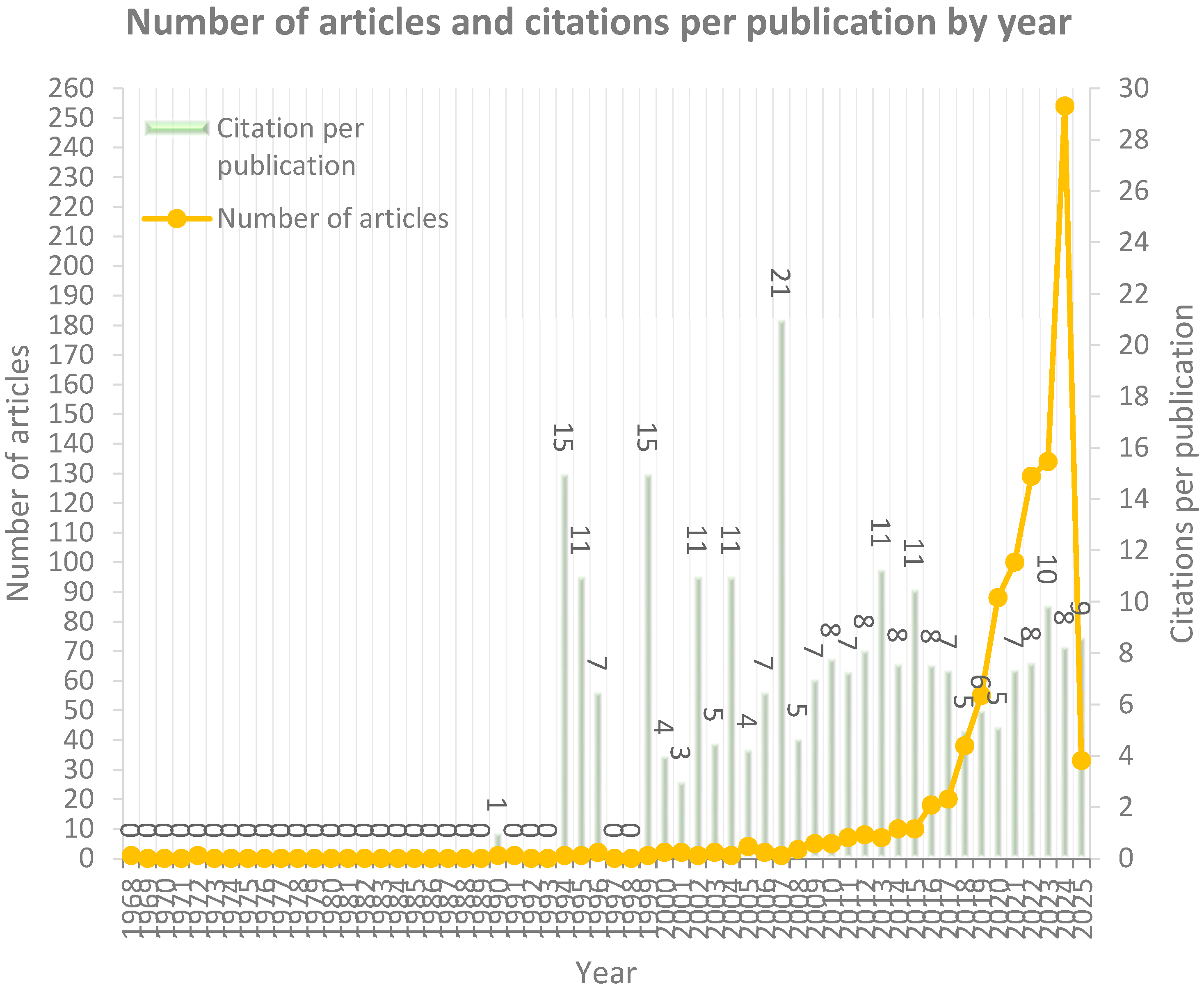
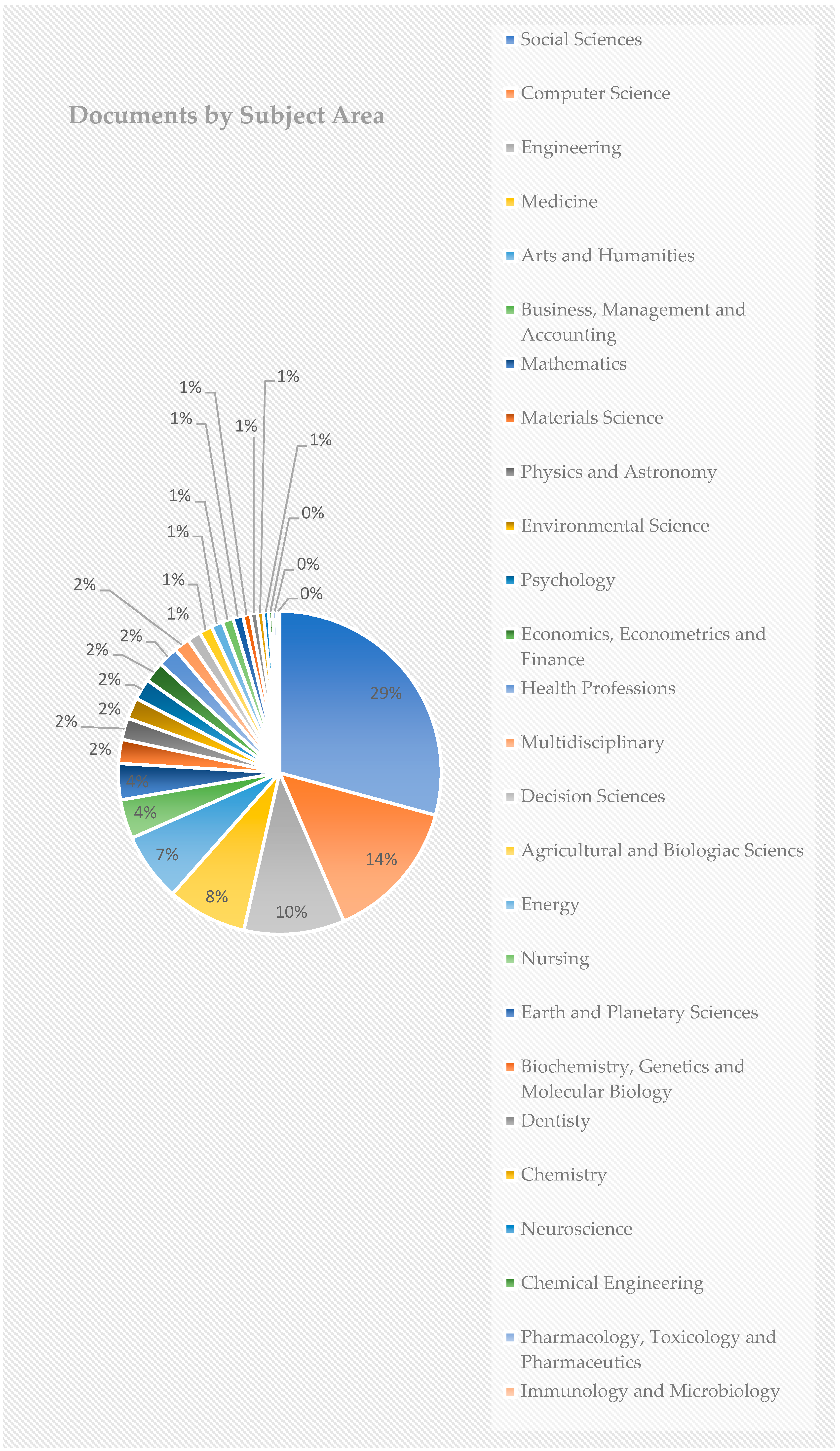
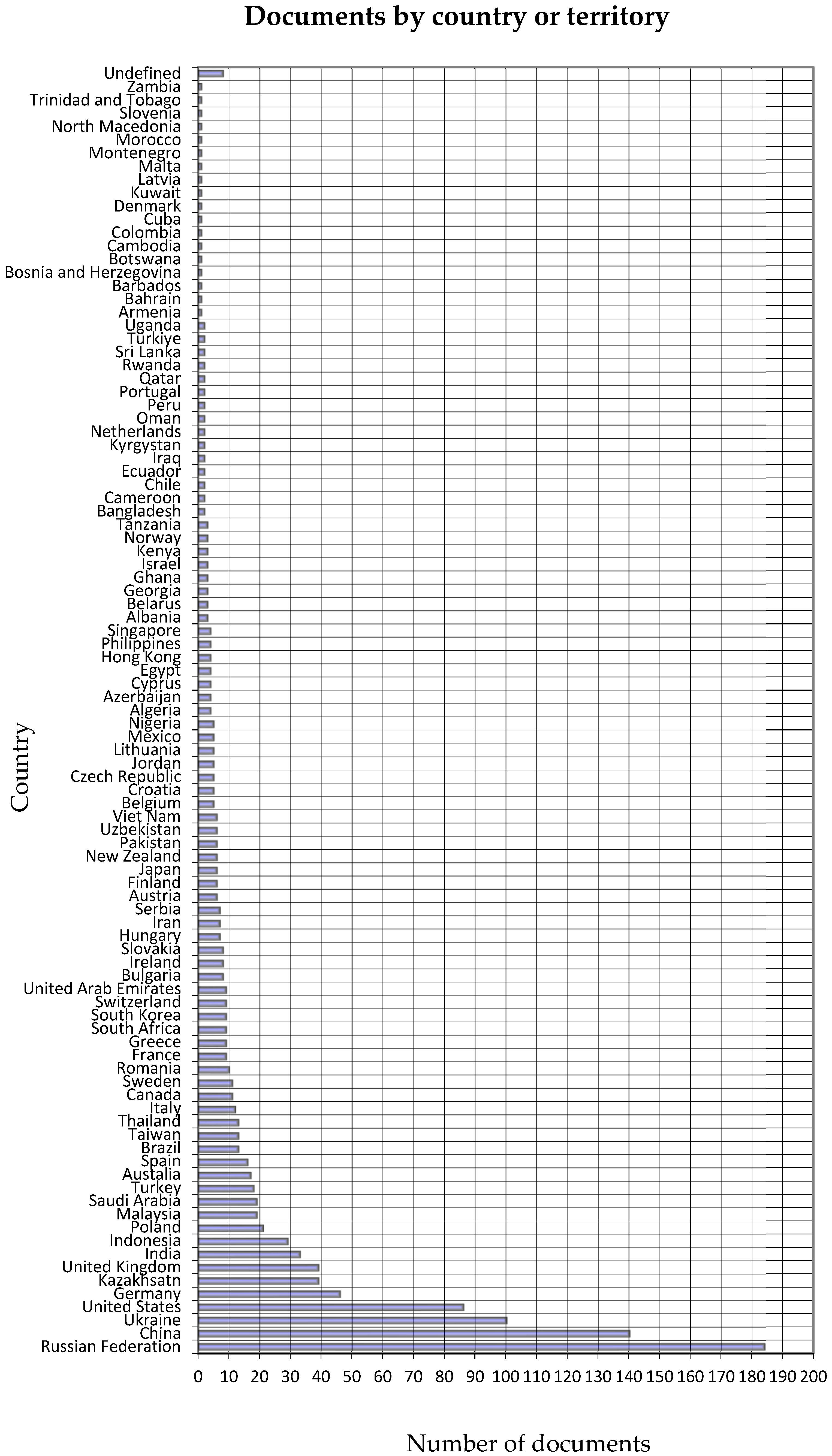

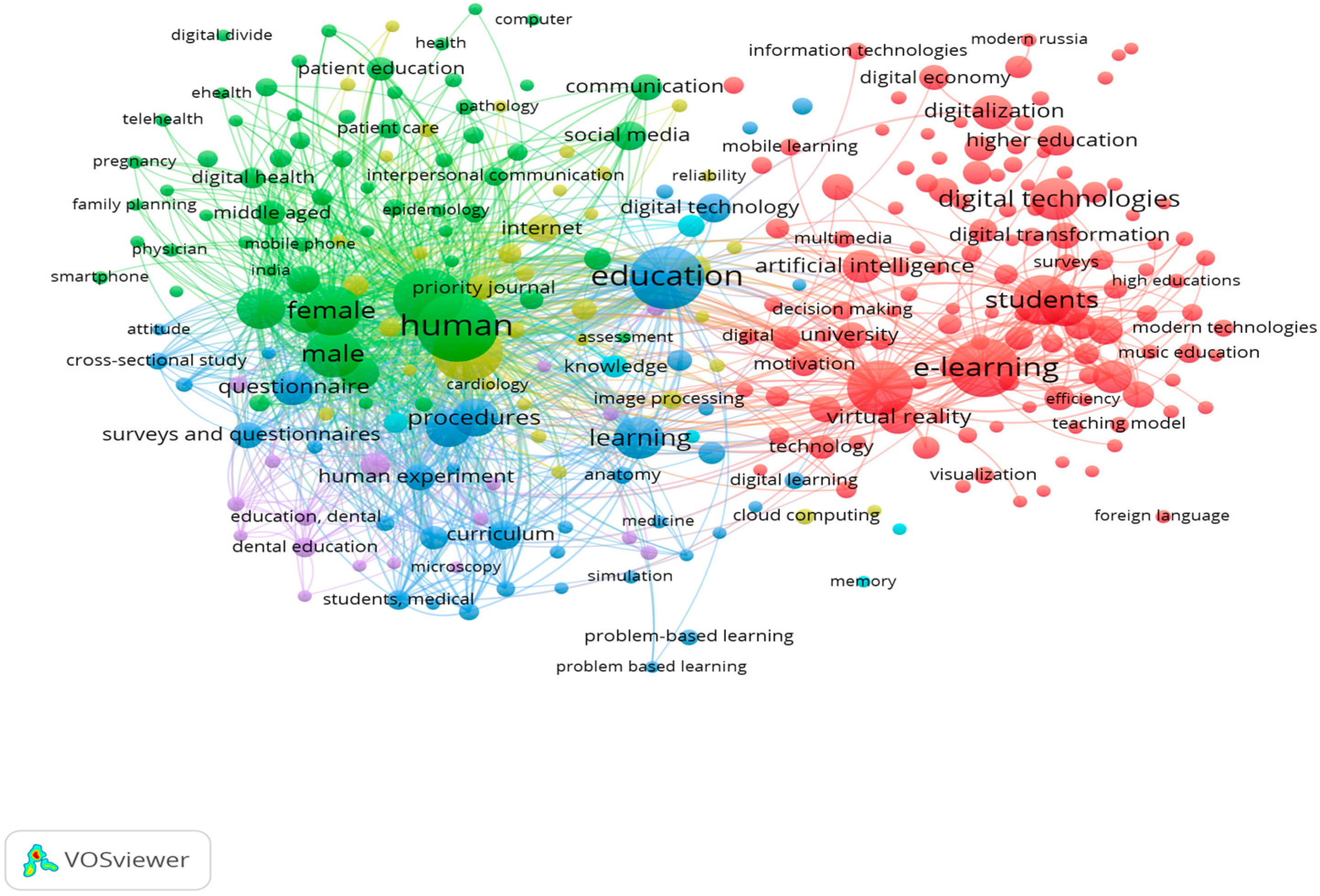
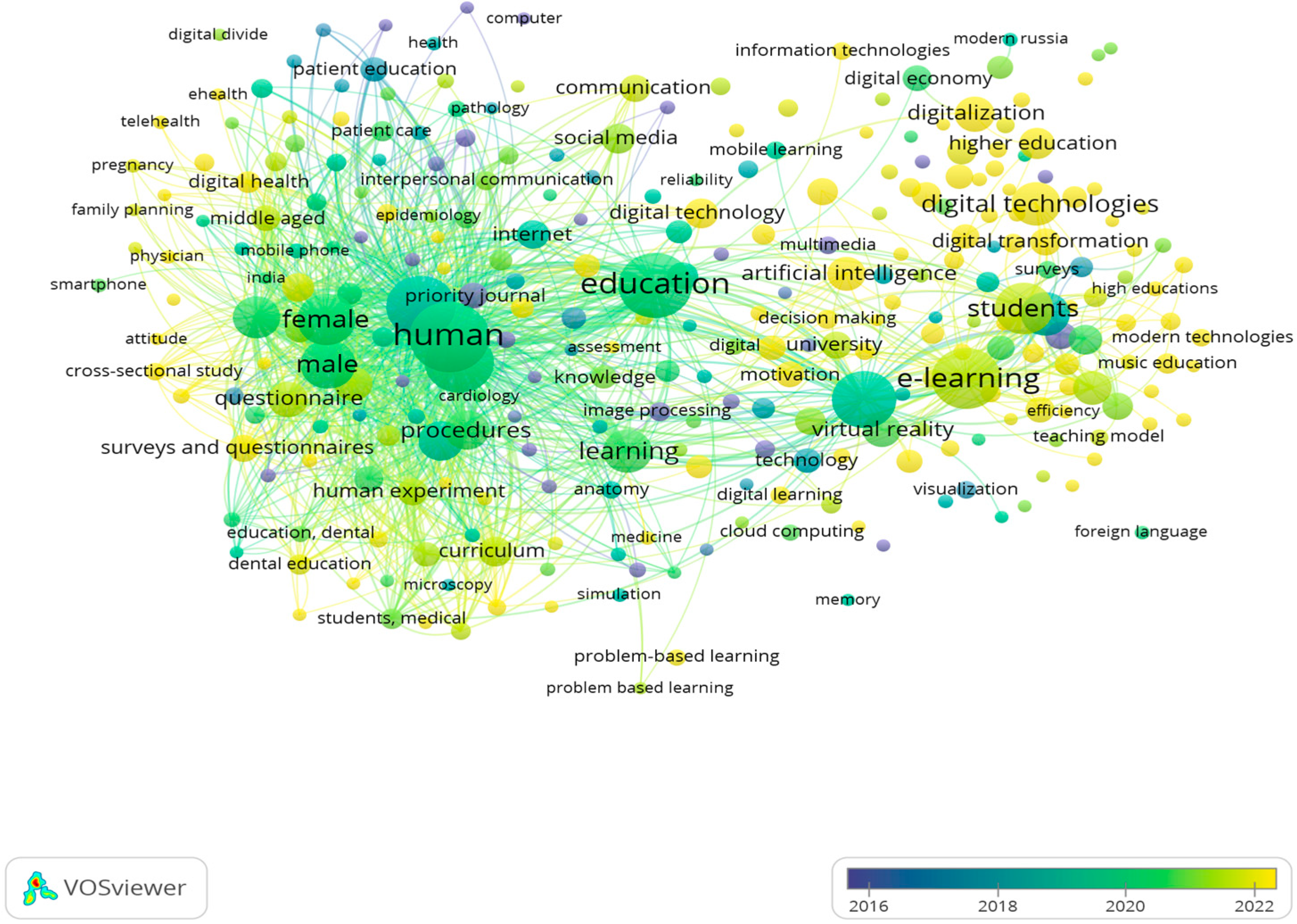
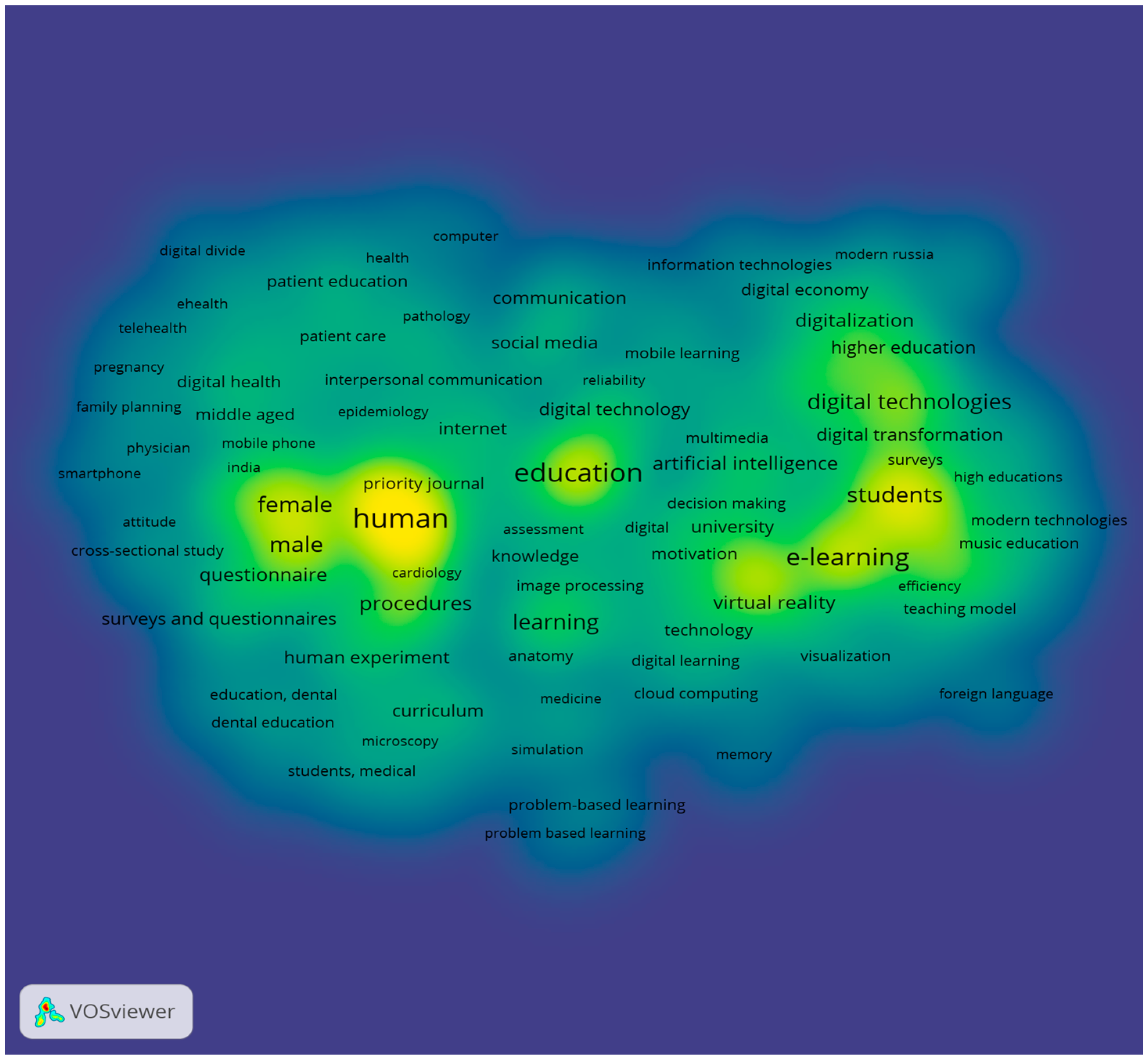
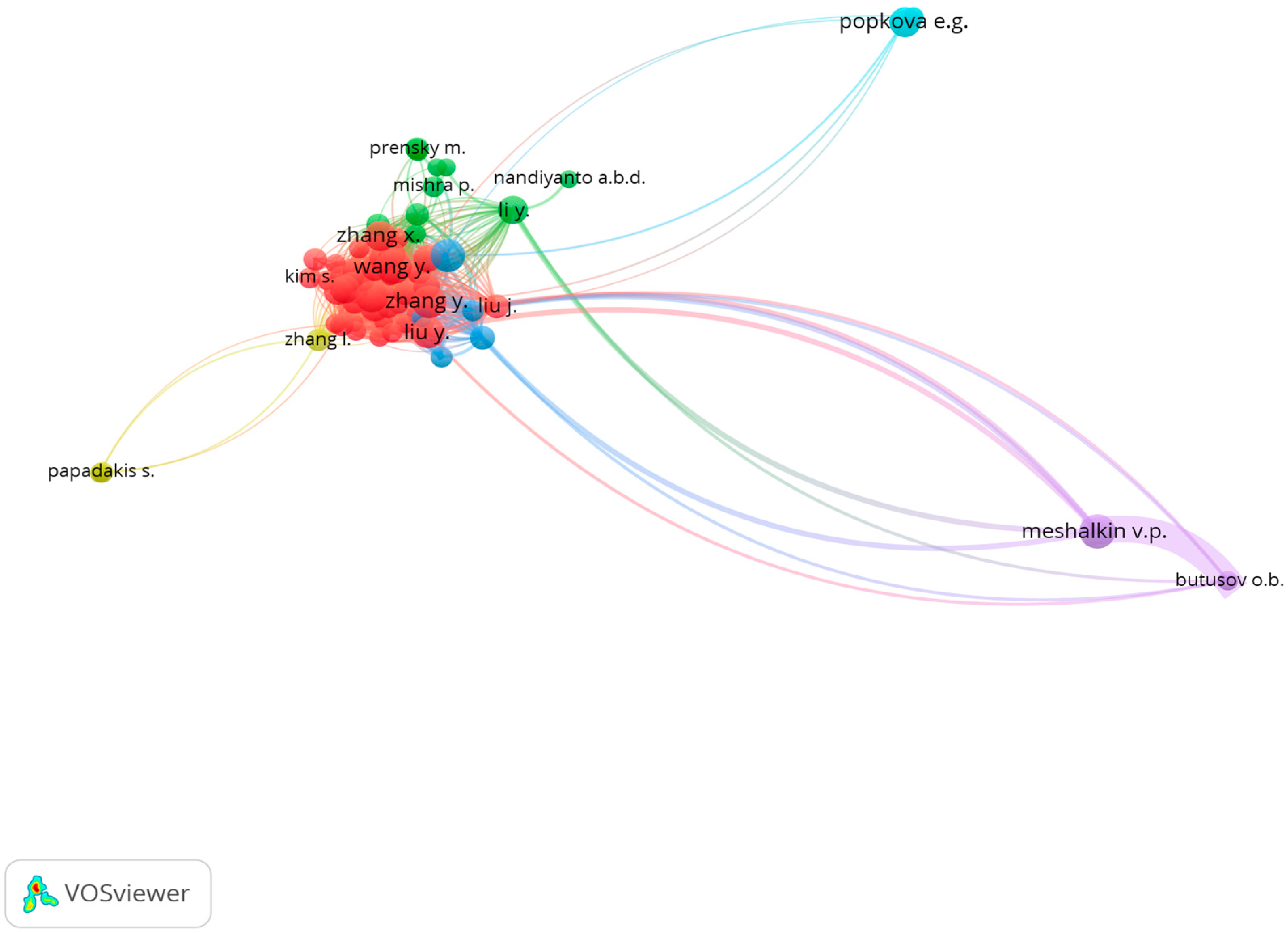
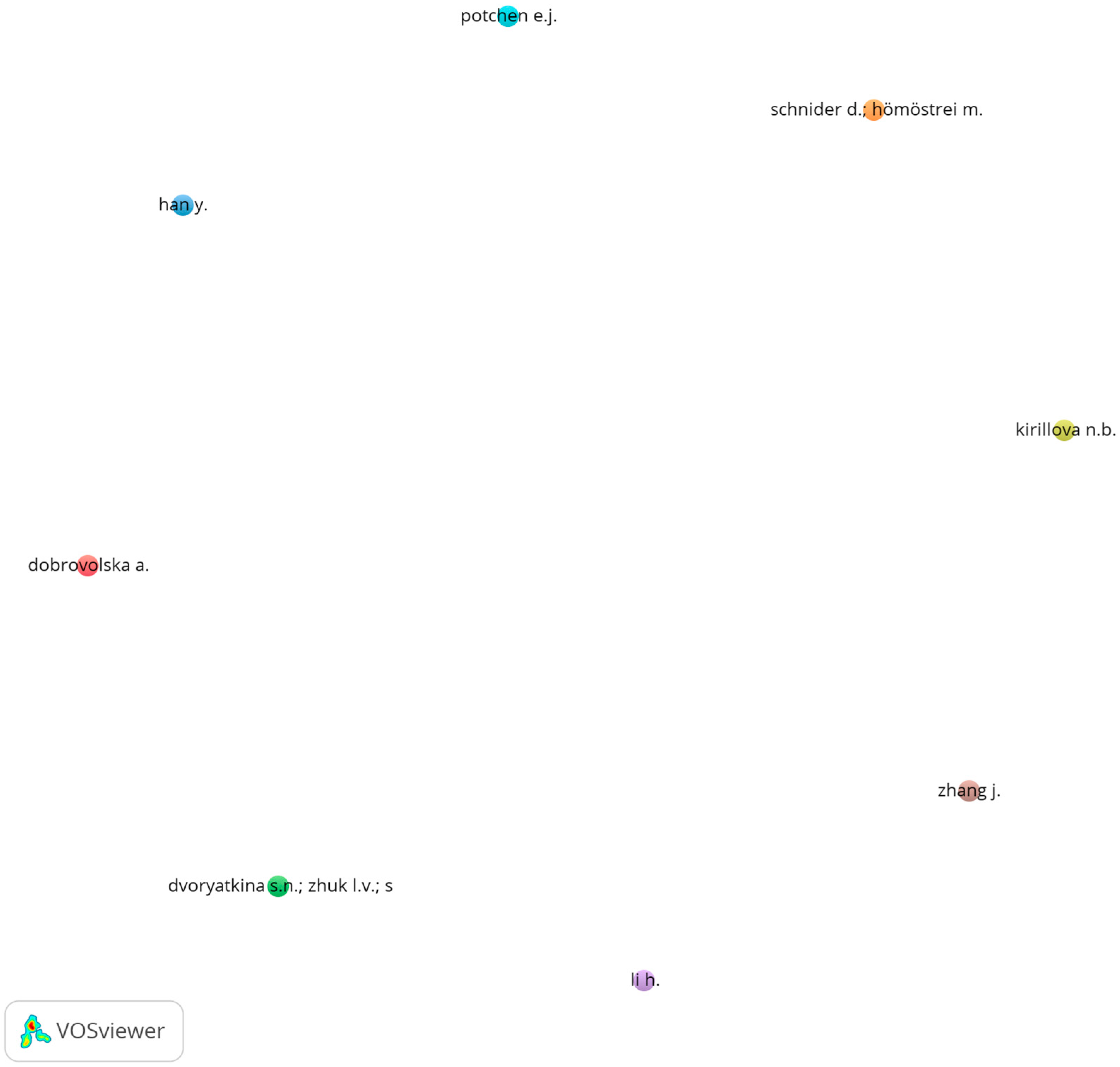
| Database | Search Within | Keywords | No. of Sources |
|---|---|---|---|
| Scopus | Article title, Abstract, Keywords | modern AND digital AND (education or teaching) AND (method or methods) | 2370 |
| Country | Number of Publications | Percentage of Total (%) | Remarks |
|---|---|---|---|
| Russia | 184 | 15.67 | Significant increase in recent years; strong institutional research focus |
| China | 140 | 11.94 | Substantial investment in educational technologies and state-driven innovation |
| Ukraine | 100 | 8.53 | Emphasis on digital access and pedagogical modernization |
| United States | 86 | 7.33 | Consistent research presence; leader in EdTech startups |
| Germany | 46 | 3.92 | Focus on blended learning models and higher education innovation |
| Kazakhstan | 39 | 3.32 | Regional development programs promoting digital transformation in education |
| United Kingdom | 39 | 3.24 | Emphasis on hybrid education and data-driven methodologies |
| India | 33 | 2.81 | Emerging contributions in mobile and low-cost learning tools |
| Indonesia | 29 | 2.47 | Expansion of online learning platforms and teacher training initiatives |
| Poland | 21 | 1.79 | Growth in research on gamification and microlearning in schools and universities |
| Documents per Organization | ||
|---|---|---|
| Country | Organization | No. of Publications |
| Russia | Vyatka State University | 28 |
| Russia | Kazan Federal University | 23 |
| Russia | Financial University under the Government of the Russian Federation | 16 |
| Russia | Sechenov First Moscow State Medical University | 13 |
| Ukraine | Interregional Academy of Personnel Management | 11 |
| Kazakhstan | Abai Kazakh National Pedagogical University | 11 |
| Ukraine | Kyiv National University of Culture and Arts | 11 |
| Russia | Plekhanov Russian University of Economics | 10 |
| Russia | HSE University | 9 |
| Russia | Moscow City Teacher Training University | 8 |
| Russia | RUDN University | 8 |
| Russia | Russian State Agrarian University—Moscow Timiryazev Agricultural Academy | 8 |
| Russia | Ural Federal University | 8 |
| Ukraine | Borys Grinchenko Kyiv Metropolitan University | 8 |
| Ukraine | Vinnytsia Mykhailo Kotsiubynskyi State Pedagogical University | 8 |
| Ukraine | Lviv Polytechnic National University | 7 |
| Kazakhstan | L.N. Gumilyov Eurasian National University | 7 |
| Russia | Russian State Social University | 7 |
| Ukraine | National Academy of Educational Sciences of Ukraine | 7 |
| Ukraine | National Technical University of Ukraine “Igor Sikorsky Kyiv Polytechnic Institute” | 6 |
| Russia | Lomonosov Moscow State University | 6 |
| Russia | Bunin Yelets State University | 6 |
| Ukraine | Bogomolets National Medical University | 5 |
| Russia | Herzen State Pedagogical University of Russia | 5 |
| Russia | Russian Academy of Sciences | 5 |
| United Kingdom | University College London | 5 |
| Ukraine | Taras Shevchenko National University of Kyiv | 5 |
| Russia | Bauman Moscow State Technical University | 5 |
| Russia | Moscow Aviation Institute National Research University | 5 |
| Kazakhstan | Al Farabi Kazakh National University | 5 |
| Kazakhstan | Buketov Karagandy University | 5 |
| Russia | K.D. Ushinsky Yaroslavl State Pedagogical University | 5 |
| Russia | MIREA—Russian Technological University RTU MIREA | 5 |
| New Zealand | The University of Auckland | 4 |
| Mexico | Tecnológico de Monterrey | 4 |
| Ukraine | National Academy of Sciences of Ukraine | 4 |
| Russia | The State University of Management | 4 |
| Germany | Rheinisch-Westfälische Technische Hochschule Aachen | 4 |
| Canada | University of Toronto | 4 |
| Australia | Deakin University | 4 |
| Germany | Universitätsklinikum und Medizinische Fakultät Tübingen | 4 |
| Russia | Southern Federal University | 4 |
| Ukraine | V. N. Karazin Kharkiv National University | 4 |
| United States of America | Michigan State University | 4 |
| Russia | Saint Petersburg State University | 4 |
| Russia | Siberian Federal University | 4 |
| Ukraine | South Ukrainian National Pedagogical University named after K. D. Ushynsky | 4 |
| Ukraine | Luhansk Taras Shevchenko National University | 4 |
| Kazakhstan | M. Auezov South Kazakhstan University | 4 |
| Ukraine | Kamianets-Podilskyi Ivan Ohiienko National University | 4 |
| Russia | Moscow Polytechnic University | 4 |
| Crimea | V.I. Vernadsky Crimean Federal University | 4 |
| Saudi Arabia | Prince Sattam Bin Abdulaziz University | 4 |
| Germany | Klinikum der Universität München | 3 |
| Russia | Moscow Institute of Physics and Technology | 3 |
| China | Ministry of Education of the People’s Republic of China | 3 |
| Malaysia | Universiti Kebangsaan Malaysia | 3 |
| Slovakia | Univerzita Komenského v Bratislave | 3 |
| South Africa | University of South Africa | 3 |
| United Kingdom | The University of Manchester | 3 |
| Malaysia | Universiti Teknologi MARA | 3 |
| Singapore | Nanyang Technological University | 3 |
| United States of America | Mayo Clinic | 3 |
| China | Nanchang University | 3 |
| Croatia | University of Zagreb | 3 |
| Germany | Uniklinik Köln | 3 |
| Sweden | Linköpings Universitet | 3 |
| Switzerland | Universität Zürich | 3 |
| Germany | Julius-Maximilians-Universität Würzburg | 3 |
| United States of America | University of Maryland School of Medicine | 3 |
| United States of America | Northwestern University Feinberg School of Medicine | 3 |
| Taiwan | National Yunlin University of Science and Technology | 3 |
| Germany | Eberhard Karls Universität Tübingen | 3 |
| Russia | Altai State University, Barnaul | 3 |
| China | Guangxi Normal University | 3 |
| Ukraine | Oles Honchar Dnipro National University | 3 |
| Turkey | Ege Üniversitesi | 3 |
| China | Shanghai Jiao Tong University | 3 |
| Hungary | Eötvös Loránd Tudományegyetem | 3 |
| United Kingdom | University of Southampton | 3 |
| Germany | Charité—Universitätsmedizin Berlin | 3 |
| United Kingdom | University of Oxford | 3 |
| United States of America | Mayo Clinic Scottsdale-Phoenix, Arizona | 3 |
| China | University of Chinese Academy of Sciences | 3 |
| Germany | Ludwig-Maximilians-Universität München | 3 |
| Germany | Universitätsklinikum Erlangen | 3 |
| Ukraine | Odessa National Medical University | 3 |
| Russia | Moscow State Institute of International Relations MGIMO | 3 |
| Ukraine | Yuriy Fedkovych Chernivtsi National University | 3 |
| Russia | Moscow Pedagogical State University | 3 |
| Russia | Belgorod State University | 3 |
| Indonesia | Universitas Sebelas Maret | 3 |
| Russia | Platov South-Russian State Polytechnic University NPI | 3 |
| India | K L Deemed to be University | 3 |
| Jordan | Amman Arab University | 3 |
| China | Harbin University | 3 |
| Ukraine | West Ukrainian National University | 3 |
| Ukraine | Zhytomyr Ivan Franko State University | 3 |
| Ukraine | Dragomanov Ukrainian State University | 3 |
| Saudi Arabia | University of Ha’il | 3 |
| Russia | Russian State Vocational Pedagogical University | 3 |
| Roumania | Bucharest University of Economic Studies | 3 |
| Ukraine | Drohobych Ivan Franko State Pedagogical University | 3 |
| Ukraine | Donbas State Pedagogical University | 3 |
| Ukraine | Mykolayiv National Agrarian University | 3 |
| Turkey | Khoja Akhmet Yassawi International Kazakh-Turkish University | 3 |
| Russia | Taganrog Institute of Management and Economics | 3 |
| Ukraine | State Higher Educational Institution “University of Educational Management” of National Academy of Educational Sciences of Ukraine | 3 |
| Kazakhstan | Astana IT University | 3 |
| Ukraine | Khortytsia National Academy | 3 |
| Ukraine | Oleksandr Dovzhenko Hlukhiv National Pedagogical University | 3 |
| Ukraine | Institute of Pedagogy of the National Academy of Educational Sciences of Ukraine | 3 |
| Ukraine | Khmelnytskyi Humanitarian-Pedagogical Academy | 3 |
| Ukraine | Classic Private University | 3 |
| Hungary | Fazekas Mihály Primary and Secondary School | 2 |
| China | Hainan Vocational University of Science and Technology | 2 |
| Germany | Deutsche Schule Budapest | 2 |
| Germany | University of Münster | 2 |
| Iran | Urmia University | 2 |
| Germany | Humboldt-Universität zu Berlin | 2 |
| United kingdom | Loughborough University | 2 |
| Malaysia | Universiti Sains Malaysia | 2 |
| China | Guangdong Polytechnic Normal University | 2 |
| United kingdom | The University of Sheffield | 2 |
| Sweden | The Royal Institute of Technology KTH | 2 |
| United States of America | Harvard Medical School | 2 |
| Russia | Bashkir State Medical University | 2 |
| United States of America | The Ohio State University | 2 |
| Spain | Universidad de Málaga | 2 |
| Saudi Arabia | King Abdulaziz University | 2 |
| Hungary | Pécsi Tudományegyetem | 2 |
| Germany | Universitätsklinikum Hamburg-Eppendorf | 2 |
| Ireland | University College Dublin | 2 |
| Russia | Kuban State Agrarian University | 2 |
| United States of America | Johns Hopkins University | 2 |
| Germany | Ruhr-Universitat Bochum | 2 |
| United States of America | College of Sciences | 2 |
| Taiwan | National Taiwan University | 2 |
| South Africa | Tshwane University of Technology | 2 |
| United States of America | Johns Hopkins Medicine | 2 |
| China | The University of Hong Kong | 2 |
| Slovakia | Slovak University of Technology in Bratislava | 2 |
| Finland | Turun yliopisto | 2 |
| Russia | Pacific National University | 2 |
| Russia | Ural State Law University | 2 |
| Germany | Goethe-Universität Frankfurt am Main | 2 |
| United States of America | University of Kansas Medical Center | 2 |
| India | Amrita Institute of Medical Sciences India | 2 |
| Brazil | Universidade de São Paulo | 2 |
| United kingdom | University of Salford | 2 |
| Russia | Moscow State University of Psychology and Education | 2 |
| Russia | Irkutskij Gosudarstvennyj Tehniceskij Universitet | 2 |
| Canada | University of Montreal | 2 |
| Turkey | Ege University Medical School | 2 |
| Russia | University of Tyumen | 2 |
| Russia | National University of Oil and Gas «Gubkin University» | 2 |
| Nigeria | University of Ilorin | 2 |
| Germany | Universitätsklinikum Ulm | 2 |
| Ireland | Trinity College Dublin | 2 |
| No. | Articles | Citations |
|---|---|---|
| 1 | Kokotsaki, D., Menzies, V., Wiggins, A., Project-based learning: A review of the literature (2016), Journal Improving Schools, vol. 19, no. 3, pp. 267–277 [20] | 717 |
| 2 | Hatzinakos, D., Chrysostomos, L., Blind Equalization Using a Tricepstrum-Based Algorithm (1991), Journal IEEE Transactions on Communications, vol. 39, no. 5, pp. 669–682 [21] | 161 |
| 3 | Kessler, H., Mathers, S., Sobisch, H.-G., The capture and dissemination of integrated 3D geospatial knowledge at the British Geological Survey using GSI3D software and methodology (2009), Journal Computers and Geosciences, vol. 35, no. 6, pp. 1311–1321 [22] | 142 |
| 4 | Fierson, W. M., Capone, A., Gramet, D. B., Blocker, R. J., Bradford, G. E., Ellis, G. S., Lehman, S. S., Rubin, S. E., Siatkowski R. M., Ruben J. B., Telemedicine for evaluation of retinopathy of prematurity (2015) Journal Pediatris, vol. 135, no. 1 pp. e238–e254 [23] | 137 |
| 5 | Wen, K. Y., Kreps, G., Zhu, F., Miller, S., Consumers’ perceptions about and use of the Internet for personal health records and health information exchange: Analysis of the 2007 Health Information National Trends Survey (2010), Journal of Medical Internet Research, vol. 12, no. 4, pp. e73p.1–e73p.16 [24] | 112 |
| 6 | Chen, X., Chang-Richards, A. Y., Pelosi, A., Yaodong, J., Xueson, S., Siddiqui, M. K., Yang, N., Implementation of technologies in the construction industry: a systematic review (2022), Journal Engineering, Construction and Architectural Management, vol. 29, no. 8, pp. 3181–3209 [25] | 106 |
| 7 | Tavel, M., Cardiac auscultation: A glorious past—and it does have a future! (2006), Journal Circulation, vol. 113, no.9, pp. 1255–1259 [26] | 101 |
| 8 | Cukurova, M., Luckin, R., Millan, E., Mavrakis, M., The NISPI framework: Analysing collaborative problem-solving from students’ physical interactions (2018), Journal Computers and Education, vol. 116, pp. 93–109 [27] | 94 |
| 9 | O’Reilly, M. K., Reese, S., Herlihy, T., Geoghegan, T., Cantwell, C. P., Feeney, R. N. M., Jones, J. F. X., Fabrication and assessment of 3D printed anatomical models of the lower limb for anatomical teaching and femoral vessel access training in medicine (2016), Journal Anatomical Sciences Education, vol. 9, no. 1, pp. 71–79 [28] | 94 |
| 10 | Montello, D. R., Cognitive research in GI science: Recent achievements and future prospects (2009), Journal Geography Compass, vol. 3, no. 5, pp. 1824–1840 [29] | 78 |
| 11 | Mustafa, N., Ismail, Z., Tasir, Z., Mohamad Said, M. N. H., A meta-analysis on effective strategies for integrated STEM education (2016), Journal Advanced Science Letters, vol. 22, no. 12, pp. 4225–4288 [30] | 74 |
| 12 | Huang, C., Designing high-quality interactive multimedia learning modules (2005), Journal Computerized Medical Imaging and Graphics, vol. 29, no. 2–3, pp. 223–233 [31] | 73 |
| 13 | Liu, Z. Y., Shaikh, Z. A., Gazizova, F., Using the concept of game-based learning in education (2020), International Journal of Emerging Technologies in Learning, vol. 15, no. 14, pp. 53–64 [32] | 72 |
| 14 | Ren, Z., Wan, J., Deng, P., Machine-Learning-Driven Digital Twin for Lifecycle Management of Complex Equipment (2022), Journal IEEE Transactions on Emerging Topics in Computing, vol. 10, no. 1, pp.9–22 [33] | 69 |
| 15 | Liu, Z. J., Tretyakova, N., Federov, V., Kharakhording, M., Digital literacy and digital didactics as the basis for new learning models development (2020), International Journal of Emerging Technologies in Learning, vol. 15, no. 14, pp. 4–18 [34] | 67 |
| 16 | Fuchsova, M., Korenova, L., Visualisation in basic science and engineering education of future primary school teachers in human biology education using augmented reality (2019), European Journal of Contemporary Education, vol. 8, no. 1, pp. 92–102 [35] | 66 |
| 17 | Parham, G. P., Mwanahamuntu, M. H., Pfaendler, K. S., Sahasrabuddhe, V. V., Myung, D., Mkumba, G., Kapambwe, S., Mwanza, B., Chibwesha, C., Hicks, M. L., Stringer, J. S. A., EC3-A modern telecommunications matrix for cervical cancer prevention in Zambia (2010), Journal of Lower Genital Tract Disease, vol. 14, no. 3, pp. 167–173 [36] | 64 |
| 18 | Frolova, E. V., Rogach, O. V., Ryabova, T. M., Digitalization of education in modern scientific discourse: New trends and risks analysis (2020), European Journal of Contemporary Education, vol. 9, no. 2, pp. 331–336 [37] | 61 |
| 19 | Calazans, N. L. V., Moraes, F. G., Digitalization of education in modern scientific discourse: New trends and risks analysis (2001), Journal IEEE Transactions on Education, vol. 44, no. 2, pp. 109–119 [38] | 57 |
| 20 | Mesko, B., Gyrffy, Z., Kollár, J., Digital literacy in the medical curriculum: A course with social media tools and gamification (2015), JMIR Medical Education, vol. 1, no. 2 [39] | 56 |
| Method | Strengths | Challenges | Examples of Tools |
|---|---|---|---|
| Adaptive Learning | Personalized pace, data-driven feedback | Teacher training, algorithm overreliance | Knewton, Smart Sparrow |
| Gamification | Increased engagement, social learning | Risk of distraction, implementation quality | Kahoot!, Quizizz |
| Microlearning | Bite-sized content, flexibility | Limited depth, fragmented learning | Duolingo, EdApp |
| VR/AR | Immersive experience, experiential learning | High cost, technical limitations | ClassVR, Nearpod |
Disclaimer/Publisher’s Note: The statements, opinions and data contained in all publications are solely those of the individual author(s) and contributor(s) and not of MDPI and/or the editor(s). MDPI and/or the editor(s) disclaim responsibility for any injury to people or property resulting from any ideas, methods, instructions or products referred to in the content. |
© 2025 by the authors. Licensee MDPI, Basel, Switzerland. This article is an open access article distributed under the terms and conditions of the Creative Commons Attribution (CC BY) license (https://creativecommons.org/licenses/by/4.0/).
Share and Cite
Stoumpos, A.I.; Stoumpou, R.I. Modern Digital and Technological Educational Methods. Trends High. Educ. 2025, 4, 25. https://doi.org/10.3390/higheredu4020025
Stoumpos AI, Stoumpou RI. Modern Digital and Technological Educational Methods. Trends in Higher Education. 2025; 4(2):25. https://doi.org/10.3390/higheredu4020025
Chicago/Turabian StyleStoumpos, Angelos I., and Rodanthi I. Stoumpou. 2025. "Modern Digital and Technological Educational Methods" Trends in Higher Education 4, no. 2: 25. https://doi.org/10.3390/higheredu4020025
APA StyleStoumpos, A. I., & Stoumpou, R. I. (2025). Modern Digital and Technological Educational Methods. Trends in Higher Education, 4(2), 25. https://doi.org/10.3390/higheredu4020025






